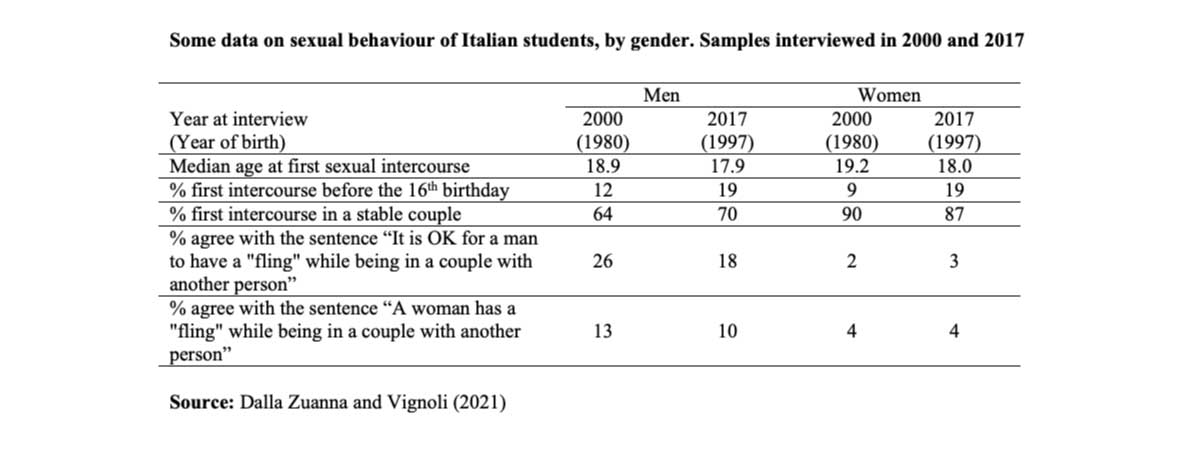Sexual intercourse is starting earlier than before among Italian adolescents, whose behaviour is converging towards the norms of their European peers. As noted by Gianpiero Dalla Zuanna and Daniele Vignoli, this precocity and the growing importance attached to romantic love are not affected by either the intense material and symbolic exchanges with parents or the (increasingly) delayed transition to adulthood.
Recent studies comparing different aspects of youth sexuality between countries and over time are relatively rare. In Italy, for instance, the latest national research based on a large statistical sample dates back to 2006 (Barbagli et al. 2010). The Sexual and Emotional Life of Youths (SELFY) survey—coordinated by Marcantonio Caltabiano, Gianpiero Dalla Zuanna, Alessandra Minello and Daniele Vignoli—aims to fill this gap, at least in part (Minello et al. 2020).
In 2017, a questionnaire was administered to 8,000 economics and statistics undergraduates, born around 1998, at 28 Italian universities. SELFY replicates an identical survey, Sexuality of Italian Students (SIS), conducted in 2000, in which 5,000 economics and statistics students born around 1980 self-completed the same closed-ended questionnaire during an hour of class time. The comparison between SIS and SELFY sheds light on many aspects of the emotional and sexual behaviour of contemporary Italian youth. The main findings are presented in a recent publication (Dalla Zuanna and Vignoli 2021), and summarized below.
The sexualization of adolescence
Sex is more important in the lives of millennials than it was among their parents and older siblings, and the emotional experiences of adolescents have become sexualized. For half of the students in all Italian regions, first sexual intercourse takes place before their 18th birthday, one or two years earlier than their parents, and only a small fraction of students are still virgins on their 21st birthday. The frequency of sexual intercourse has also increased. Discussing sex with friends and exchanging explicit erotic images via smartphone or computer is more common, and fewer young people consider virginity and chastity to be important values. It is also likely that all these behaviours and attitudes are more strongly sexualized in the population as a whole, as the students of the SIS and SELFY surveys are less sexually precocious and have less intense sexual lives than their peers (Minello et al. 2020).
These changes are consistent with the trends observed in the generations of the millennials’ grandparents, parents, and older siblings, and in Northern and Central Europe (Barbagli et al. 2010, 297; Kontula 2009; Mercer 2013). The sexual debut of Italian youth no longer occurs at a later age than their European peers, and differences between the Italian regions have narrowed considerably. Other internal differences within the Italian population have also diminished, starting with religiosity, until recently a strongly discriminating factor (Barbagli et al. 2010, chap. 9). Not only has the religious practice of young people decreased drastically over the last twenty years, but many millennials close to the church also behave similarly to non-religious people, no longer attaching importance to chastity or seeing sexuality solely in terms of its reproductive function. This process of convergence—across the countries of Europe and across different social groups and territories within Italy—is similar to that observed for other components of the Second Demographic Transition such as nonmarital cohabitation and childbearing (Lesthaeghe 2020).
The revival of romantic love
Less obvious is the revival of romantic love in the context of intimate relationships. There are several signs of this new trend. Being unfaithful is rarer among millennials than among previous generations, and the vast majority of surveyed students believe that infidelity is incompatible with being in a couple. Frequency of sexual intercourse is much higher among couples than among singles. Both single men and women who are no longer virgins practice casual intercourse, but only a small minority of singles adopt casual sex as a lifestyle. Compared to previous generations, the average annual number of partners has decreased in the first stages of sexual life.
While single non-virgins are, on average, sexually dissatisfied, almost all of those in a relationship report being sexually satisfied. In short, in the first years of sexual life, millennials do not assign a predominantly hedonistic meaning to sexuality as may have been the case among older male generations (Barbagli et al. 2010, 296). On the contrary, in their emotional lives, sex and love are closely interrelated from the moment of first sexual intercourse.
Both in Italy and elsewhere in Europe (Kontula 2009, chap. 8), the revival of romantic love seems to be part of a more general revolution in intimacy. One of the key changes in contemporary intimate life is the emphasis placed on attraction between partners as the constitutive basis of the couple relationship, which goes hand in hand with the de-institutionalization of the relationship itself (Van de Kaa 1987). This emphasis is also the basis of other features of the Second Demographic Transition, such as the disappearance of arranged marriages, the spread of cohabitation, extra-nuptial births, and union dissolution. If mutual attraction is a precondition for the very existence of a couple relationship, everything else takes a back seat: “If we love each other, what is the point of getting married?” “If we don’t love each other anymore, what’s the point of being together?” and so on. Even if marriage represents a distinct arrangement as compared to cohabitation due to its higher level of commitment, infidelity becomes difficult to justify, irrespective of the type of union, because it testifies to a weakening or lack of mutual attraction. Sex with occasional partners also loses much of its charm because physical attraction is only one of the components of attraction between partners, necessary but not sufficient to achieve complete sexual satisfaction.
Becoming adults
What is the place of sexuality in the larger context of emerging adulthood in Italy (Arnett 2014)? In many ways, the sexual behavior of young Italians is converging with that of their European peers, similarly to what is happening in other aspects of the Second Demographic Transition, such as the practice of living together before (or instead of) getting married, or having children outside marriage (Pirani and Vignoli 2016).
In our book (Dalla Zuanna and Vignoli 2021), we also show that the sexuality and attachment to romantic love of Italian adolescents, whose behaviour is converging towards the norms of their European peers, is not affected by either the tradition of strong material and symbolic family bonds, which persists, or the postponement of independent living that characterizes emerging adulthood in the Bel Paese.

References
Arnett, J.J. 2014 Emerging adulthood: the winding road from the late teens through the twenties, Oxford, Oxford University Press.
Barbagli, M., Dalla Zuanna, G. and Garelli, F. 2010 La sessualità degli italiani, Bologna, Il Mulino.
Billari, F.C., Caltabiano, M. and Dalla Zuanna, G. (a cura di) 2007 Sexual and affective behaviour of students. An international research, Padova. Cleup.
Dalla Zuanna, G. and Vignoli, D. 2021 Piacere e fedeltà. I millennials italiani e il sesso, Bologna, il Mulino.
Kontula, O. 2009 Between sexual desire and reality. The evolution of sex in Finland, Helsinky, Publications of the Population Research Institute, D49.
Lesthaeghe, R. 2020 The second demographic transition, 1986–2020: sub-replacement fertility and rising cohabitation – a global update, Genus, 76, 10: on-line.
Mercer, C.H. et al. 2013 Changes in sexual attitudes and lifestyles in Britain through the life course and over time: findings from the National Surveys of Sexual Attitudes and Lifestyles (Natsal), Lancet, 382: 1781-1794.
Minello, A., Caltabiano, M., Dalla Zuanna, G. and Vignoli, D. 2020 Catching up! The sexual behaviour and opinions of Italian students (2000-2017), Genus, 76, 16: on-line.
Pirani, E. and Vignoli, D. (2016). Changes in the satisfaction of cohabitors relative to spouses over time, Journal of Marriage and Family, 78(3): 598-609.
Van de Kaa, D.J. 1987 Europe’s second demographic transition, Population Bulletin, 42(1): 1-57.


